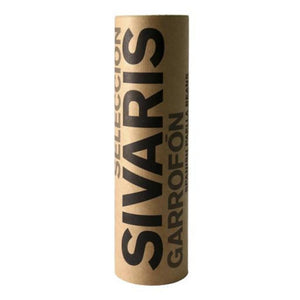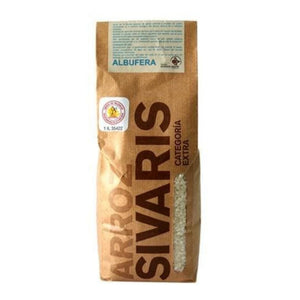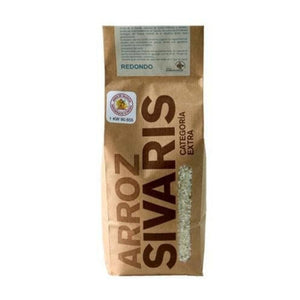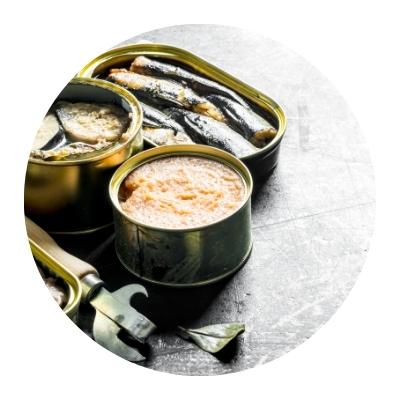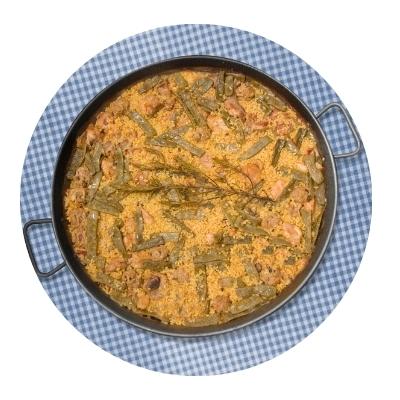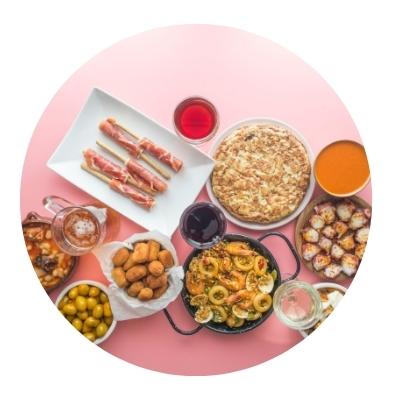Getting to know Sivaris (producer of Bomba rice and Garrofons)

"We are convinced that it is more honest with our customers to have the entire growth and production process in our own hands, and to watch over it," says Miguel Miquel (*1974), at least the fourth generation of rice farmers from Valencia, and managing director of Sivaris in the Colono-Gourmet exclusive interview with Jan. They are the first and so far, the only ones to cultivate an organic paella rice in l'Albufera nature reserve. And whose top products, rice and typical Garrofón paella beans are relied on by star chefs worldwide, including Quique Dacosta, Ricard Camarena or Pepe Sanchís. Find out first-hand what is essential in growing rice, how it came to Valencia over one thousand years ago, and why Bomba rice is a very special one!
Question: I am very curious to hear what you are going to tell me about rice growing in Valencia and Alicante, and about the "garrofóns", the typical paella beans. You and your family have been growing rice for - if I am not mistaken - four generations in the nature reserves Parque Natural de l'Albufera in Valencia and the Marjal de Pego-Oliva near Alicante, on ...
Answer: ... I am from Castellár-L'Oliveral, a municipality of Valencia, once separated as a suburb, long since incorporated into the urban area. It is a historic rice-growing area, my grandparents and all my family are from this zone. They were all born within a four-kilometre radius. And my great-grandparents were already rice farmers, and likely so were the generations before them. Rice was simply the typical, traditional thing that was cultivated here as a farmer. We do not know exactly how long our families have been cultivating rice, but at least 150-200 years.
Question: What was your first contact with rice cultivation?
Answer: In my family, rice was like compulsory military service in a way (laughs). Only we did not realise it. Even as a small child, my father took me to the fields, and even when I was studying at university, I always spent the summers here, working with the family and helping the harvesters. It was a summer job for me, and handy as a student to be able to finance my travels. And to cover my expenses during the semesters. Then came my phase as a consultant, in engineering, and when I suddenly had to come back, I thought to myself. Wait a minute, I do not know anything about rice cultivation. I have never done it! But on the spot, I quickly found out, I had lived and done it all since my childhood years and had picked up a great deal of knowledge. Much more than I could have imagined. Much more than I was aware of. When my father fell ill, everything had to happen quickly. From the moment he left the company, I had just under a year and a half for him to teach me everything else I lacked in knowledge.
Question: And your brothers, do they also help in the company?
Answer: No, my father still collaborated with his brother, my uncle. But my uncle has long since retired. And my father finally succumbed to lung cancer. And I have two brothers, but they also followed my father's advice and started a career away from the rice fields. I was the only one who returned, and I have been taking care of the production ever since.
Question: What are your first memories of rice? And your first contact with production? But rice has always been omnipresent in your life anyway ...
Answer: My first memory of the rice fields is when my father took me there. I was still a small boy. My father told me to go into the field, and of course it was covered with water. Fifteen centimetres of water at least. And I did not want to go in and I did not want to go in. I was afraid (laughs). Finally, my father took me and put me inside. And I started to cry. I often remember that.
Question: And gastronomic childhood memories of rice, such as typical rice dishes of your grandmothers?
Answer: In our region, in the community and of course in my family, rice was a main part of our diet. We ate a lot of rice. Three, even four times a week. For Valencia, the most famous dish is of course Paella Valenciana. But I particularly like the rice dishes that have more stock, more liquid, are "caldoso" or "meloso" (in English: soupy and creamy). And my grandmother prepared a wonderful puchero rice, a meat stew with vegetables. Wonderful for the cold season. I often remember this rice from my grandmother.
Question: What has changed in rice production in recent years, decades? Since the era of your father, your grandfather ...
Answer: It was during my father's time that there were substantial changes. The most important was certainly the move from pure manual labour to mechanisation, with machines. My father was one of the first in our country to have a harvester, or a tractor. He experienced the change, the hard, pure manual work, with work animals and the supported by machines. And we continue to do what my father did. Fortunately, mechanisation came, rice farming was extremely hard. The way my grandfather did it, it was hard labour. Nowadays, it is more a question of varieties, there are rice varieties that yield more, that are less susceptible to pests and fungi, or that are better able to withstand storms, which are common here at the end of the summer. The steps are about the same as 30-40 years ago, but no comparison with what rice cultivation was 60-70 years ago, and more. Now we are facing another change, through mechanisation and digitalisation towards the use of drones, for example, agricultural robots and more. Europe is lagging a bit here, also because there is a lot of bureaucracy. Here we see that rice cultivation in other countries is already much, much further along, such as in the USA and Latin America, where these innovative technologies are being applied. Here in Europe, there are no self-propelled agricultural machines yet, and the use of plant protection products, specifically by drones, is also not permitted. I assume we will start with this and gradually catch up.
Question: What do you have to consider when growing rice? What are the risks? What pests? Fungi? Water shortage? Water quality?
Answer: Rice has a complete range of enemies. And I have ranked them according to risks and consequences. I start my season, my rice year, with the highest possible yield of a field in mind. And then I subtract successively, everything that happens to the rice. At the beginning there is the sowing, here 'the enemies' are primarily the bird species, primarily the ducks among others, which simply eat the seeds. That is the first problem. Flamingos, for example, do not eat grains, but with their legs and beaks they move the mud in the rice field in such a way that the grains that do not, cannot take root. These animals cause problems during sowing, and of course just before harvesting, whenever there are rice grains. When the rice plant has formed its spike. The second problem for the rice is the weeds, here we must make sure that the rice wins its battle for the space to grow. It must gain the upper hand and cover the surface. Where there is no light, no sun, no more weeds will grow. This is achieved by ploughing, weeding and, in conventional cultivated areas, by using chemical and natural means. We have fields where we use weedkillers, but also fields where we grow organic rice, or "zero waste" rice. Here, things are much more complex. It all must be done by hand, otherwise there is no way to get rid of the weeds. The third enemy of the rice plant is fungal diseases. And here in l'Albufera, rice has been cultivated for over one thousand years. The diseases that attack rice are therefore also indigenous, endemic fungal diseases of the region. Which spread because no rotation farming is possible either. There are no alternatives to rice, and rice is a basis of the unique ecosystem here. For example, Pyricularia oryzae, the rice blast fungus, or Helminthosporium oryzae. The diseases are problematic. In conventional rice cultivation we can use fungicides, but in organic rice we use natural drying agents that dry the leaves and thus deprive the fungi, especially the spores, of their food base. These agents are one hundred per cent natural, but they are only effective for a very short time, so we have to watch the organic rice fields constantly and very closely. And just at harvest time, the birds come on the scene again. Primarily small bird species that suck the contents of the rice grain, which is liquid. Because rice is liquid until it dries. When it dries, the ducks come again. And the cormorants. And the last enemy? The climate. We must harvest before the first, increasingly severe storms hit the country.
Question: In the cultivation of organic paella rice, the Arroz Redondo Ecológico, how much is left for the harvest, from the initially intended, optimal and largest amount?
Answer: Like all arable land, we need a certain amount of luck; after all, rice grows and thrives in the open air, both conventional and organic. And luckily, we always have our rice well insured. Because otherwise we would simply have to declare bankruptcy after a crop failure or a miserable harvest. And I would not sleep through a night. So, we can carry on, and reseed next year. This year we were in time. Sometimes there is a better year, sometimes a worse one. But we can go on. That is what counts. As a farmer, you must get used to that.
Question: You produce local Albufera and Bomba rice yourself, but you also buy organic rice from other regions of the world ...
Answer: We buy wild rice and Basmati rice, which has a protected designation of origin; only rice from India and Pakistan, in the certified areas, may be called this. Neither variety is suitable for cultivation here in Valencia, or in Europe. They need more hours of sunshine every day, the so-called photo period must be longer. Basmati cannot be grown in Europe, or no one has managed it yet. But we are part of a research group that wants to breed varieties like Basmati rice for Europe's rice fields. We also import the wild rice. From a botanical point of view, it is not rice at all, but another plant species. Water rice, Zizania palustris, is a pseudo-cereal. The prerequisite is a temperature below 10 degrees Celsius, which we did not reach here in Valencia (laughs). So, it is impossible to grow it here. Only in the USA and in Canada, around the "Great Lakes", are there cultivation areas. And in Northern California, cold zones with lots of water and rainfall. Nevertheless, our goal is not only to sell rice, but primarily to market the rice that we grow. We grow many, many varieties. Because we are simply in a privileged place. The first place where rice was grown in Europe. We started with the typical varieties of the region, but then also cultivated other varieties at the request of our customers. We are convinced that it is more honest with our customers to have the whole growing and production process in our own hands, and to watch over it.
Question: The origins of rice cultivation around Valencia date back to the era of Muslim-Arab rule over Spain ...
Answer: ... yes, it was the Arabs. In 711, the Arab armies crossed the Strait of Gibraltar and inflicted a crushing defeat on the Visigoths at the Battle of Guadalete in southern Andalusia. The conquest of the Iberian Peninsula lasted only three years. And rice came to Valencia with the Arabs. Primarily, it was considered a medicine at that time. And even though we talk a lot about the Arabs, it was other peoples who settled around Valencia. Because people were settled who were familiar with the area, depending on the zone, from all parts of the Caliphate. Here with us there were many Syrians and Egyptians. While in the dry inland and hinterland, it was primarily Imazighen (berbers) who found a new home. The typical wooden boats of l'Albufera also date from that time, which, if you look closely, resemble the design of the Nile barques from Egypt.
Question: Which of the rice varieties you grow is the most sensitive?
Answer: Quite clearly, the Bomba rice. This variety is the oldest Spanish one that we cultivate here in Valencia. There are written documents that prove the cultivation of this variety around the year 1800. And despite all the new varieties, and all the advances, it is a variety that simply has unique qualities. For me, it is the "grandfather" of rice varieties. Many new varieties have outlived "Bomba" because they simply cannot match it. For us rice farmers, "Bomba" is a nightmare (laughs), by far the most difficult variety. In the field, it is overly sensitive to nutrients. Too many nutrients and it is over. If you do not fertilise, you do not have a crop, and if you fertilise just a tiny, tiny bit too much, it catches fungal diseases, and you lose the crop as well. The plants grow noticeably big. A normal rice plant reaches about seventy centimetres, "Bomba" rice can easily grow 1.5 metres high. We grow this rice on phosphorus-rich soils and have plants that exceed two metres. And that every year. Because of the size, the stability suffers, and it breaks easily. And on top of all that, the "bomba" rice has hardly any yield. If the ear meets the water, it curls up and you have to untangle it manually. And a late summer thunderstorm is a disaster for this rice anyway. It is overly complicated. And that also explains the high price of "bomba" rice. It needs much more care, you have far less yield, and often we also lose most or all the harvest.
Question: What makes this variety so special?
Answer: The perfect ratio between amylose and amylopectin, plant starch. Because of this, the "Bomba" rice optimally absorbs the flavours with which it is cooked. This is essential for Spanish rice dishes, what counts. Other varieties also have this ratio, but at the same time you do not overcook it and the individual grains do not stick together. When the rice cools, it retains its flavour, and in the slight shrinkage, the grains separate from each other. Such a cultivation is extremely difficult to achieve.
Question: What is your favourite kind of rice? Knowing that certain dishes need certain varieties ...
Answer: As I said, there are two kinds of rice dishes that I, particularly love. On the one hand, the ones with a lot of liquid, "caldosos", or the "creamy" ones, "melosos". The way my grandmother makes them. I use "bomba" rice, or our albufera rice. This is an offspring of the "Bomba" rice. Not as far as the grain is concerned, it is simply easier to cultivate. In 2007, research was conducted at the University of Valencia in agricultural engineering on "Bomba" rice, which has an ideal grain but is incredibly problematic to grow. They achieved a rice, the "Albufera" rice, for us rice farmers the "super bomba", wonderful grain, less tall, less susceptible to fungal diseases, and it also survives a certain amount of over fertilization. And "Albufera" is similar to "Bomba" rice, dry you can hardly tell the grain apart. The ratio of amylose and amylopectin is also remarkably similar. But it does not separate so much from other grains when cold. The "Albufera" absorbs flavour ideally, and becomes creamier, which is just wonderful for my favourite dishes. Very pleasant in the mouth, and how the flavour transitions in the palate. In addition to these typical rice dishes and varieties, I like to cook with black rice, which is a wholemeal rice that is not whitened. Only husked. Therefore, it has a special pericarp, the fruit casing, black, with an intense own smell and taste, which makes it special. I often use this as a side dish with other dishes, or as cold rice salads. Our other rice varieties absorb flavour, in stocks and soups, and all sorts of ingredients, and the rice finally with excellent texture absorbs all that flavour, this wholemeal black rice has its own. You also must soak this one, and the water turns almost the colour of red wine, and it fills the whole kitchen with its extremely pleasant smell.
Question: I see in your Instagram profile you also give suggestions for using Sivaris rice creatively for a variety of dishes and tapas, including croquetas (not arancini!) made from the black wholemeal rice, layers of diverse types of rice with different spices and much more. But: which one gives the best "Socarrat"? The caramelised base of the rice and paella pan, highly prized by gourmets ...
Answer: (laughs) with any of our Mediterranean rice varieties you get a fine Socarrat. Be it "Bomba", or Albufera. Or the typical risotto rice Carnaroli. My favourite rice for Socarrat is Albufera, but with all the above, it works!
Question: About the garrofons, this is an old, locally typical type of bean that is an indispensable ingredient in Paella Valencia. How long has it been cultivated in the region? What are its roots, where did it originally come from?
Answer: The Garrofón is a variety of the Lima bean that came to Spain, to Valencia, from South America with the Spanish conquerors. Here they optimised the cultivations and adapted the bean to our gastronomy, one result being the garrofón pintat. There are three types, including "de la cella negra" and "ull de perdiu", as they are called in Valencian. Depending on how their grain, their pattern, is. We only have the "pintat", the most used. But their qualities are remarkably similar. When the Lima bean was brought from the Americas, they were primarily looking for improvements in productivity. The inside of the Lima bean was very mealy, and the thick skin quickly separates from the bean. In contrast, the Garrofóns of Valencia are far less productive, the inside is buttery soft, and the thin skin sticks to the bean during cooking and is extremely pleasant in the mouth. You almost do not notice it. We only started growing them three or four years ago. Also, because our customers, our buyers from the gastronomy sector, expressed the wish. We deliver to restaurants all over the world, as you know. To Australia, to China, to Kazakhstan, to Angola, and many more. And the chefs said they wanted to cook a real Paella Valenciana, but it is impossible to find Garrofóns on the market. In the beginning we bought from friends, but now we grow a small amount ourselves. Why? Because it is purely manual work, and it is not easy to cultivate the garrofóns on a large scale. But ours are very, very well received. It is a high-priced product, but ours have nothing, but really nothing in common with the white ones you get cooked in supermarkets. Once you taste our garrofóns, you will not want to go back to the standard truth. And the price? It has to do with the yield, of course, but on the other hand, you only need a few garrofóns for a plate of paella. Normally, you give four garrofóns to a portion of paella, which is the house rule. And if the four spoonfuls you eat of the paella with the bean fundamentally change the taste for the better, then the price is also worth the experience. And what do four beans cost, not the world! They are hard to get, but very, very typical of our region.
Question: Was it complicated to get the organic certification, for example for the organic round grain rice? I suppose in the nature reserve the pollution levels are low.
Answer: Getting the certificate was extremely difficult, I must admit. And we are the only ones growing organic rice in the Albufera so far. It took us three years, which is the normal time limit. The main problem is the distribution of the cultivated areas. Because the flow of water through the irrigation canals means that the cultivated areas are interconnected. You must have the first fields, because otherwise you get what your neighbour throws on the fields. Accordingly, the hectares that are suitable for organic farming are extremely limited. But once you start, your neighbouring fields can also convert to organic farming. The first, then the second, then the third. And you must have the fields that are the first. Another problem is rotation farming, which is not possible here. And you therefore always have lots of weeds. Otherwise, by changing the crops, the weeds have a different adversary every year, and accordingly they become fewer. Our fields are not intended for any other crop than rice and are also partly below sea level. The fields where we could convert are part of the nature reserve and bird sanctuary, protection zone Europe 2000, and here it is legally not possible to cultivate other plants. Precisely because rice is an essential part of the ecosystem. It is our obligation, also for the fauna here. We cannot simply cultivate maize. That makes it difficult to deal with the weeds. And as I said, organic rice cultivation is manual labour. Every year it is a challenge to produce an appealing amount of organic rice.
Question: How much cultivated area do you have? And how many employees do work for you?
Answer: We have about six hundred hectares in total, in two areas, 350 hectares in l'Albufera and about 250 hectares Marjal de Pego-Oliva near Alicante. And we have twenty-five permanent employees, and for weeding in the summer, the most important work in rice cultivation, we add about twenty temporary workers.
Question: What about your sales markets? Spain and internationally?
Answer: About 80 percent of our production goes directly to restaurants. And about 20 percent to gourmet and delicatessen shops. We sell 30 per cent internationally, and 70 per cent stays in Spain. And we deliver to thirty different countries. In addition to those already mentioned, Canada, Russia, Ukraine, the whole of Europe, of course, and Latin America. For us, it is all about quality first and foremost, and then the services we can offer our customers. The wishes they have for us, and our products are our incentive. Other companies sell copious quantities, to supermarkets, among others. We are not present in any supermarket, we supply smaller quantities, and these according to what they want from us.
Question: Which famous chefs use your rice, and garrofóns, if I may ask?
Answer: Quique Dacosta, Ricard Camarena, Pepe Sanchís, Manuel Frutos, Kike Jiménez, or Bernd Knöller, among many others.
Question: What are your plans? More varieties?
Answer: Our current challenge is to completely do without plastic in our packaging. Everything must become compostable. Since we now produce a considerable amount of "zero waste" rice and organic rice, this is the next, logical step. We have already changed a lot and have compostable packaging. We are looking for an alternative for the little plastic that is left. And it is our responsibility. And we must meet the customers' wishes here, or even be ahead of them. Both in terms of cultivation and packaging, the future is an ecological one.
Biography:
Miguel Miquel is at least a fourth-generation rice farmer and managing director at Sivaris. Born in 1974, he came to rice farming as a "rebound" as he says in basketball parlance, even though his family has been growing rice in l'Albufera near Valencia for at least four generations. "Our father called us children to study something else because he no longer believed we would be able to make a living from growing rice," says Miquel. So, he studied industrial engineering, with a master's degree in England. And he worked as a consultant for technology and industry. When Miquel's father became seriously ill, he took over the management of the family business. Miquel has a daughter with his life partner, and they are expecting a second shortly. Miquel is an enthusiastic hobby cook and spends his free time reading and travelling. Whereby he combines his hobbies with his work. Together with other young rice farmers in the region, they visit the most important rice regions in the world: Japan, the USA, all European countries where rice is grown, Argentina or the Philippines. Next year, Vietnam is planned.
Links:
SHARE:

